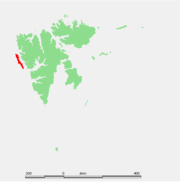
Prince Charles Foreland
Encyclopedia
Prince Charles Foreland, (Norwegian Prins Karls Forland or Forlandet), is an island in the Arctic archipelago
Svalbard
. The island is directly west of Oscar II Land
on Spitsbergen
and constitutes the western part of Svalbard. The entire island and the surrounding sea area constitutes Forlandet National Park
.

named it Black Point Isle. By 1612 the English whalers were referring to the island as Prince Charles' Foreland, after King James
's son, Charles (later king of England and Scotland). The Dutch called it Kijn Island, after a merchant, who, climbing a tall hill in 1612, fell and broke his neck. The English built a temporary whaling
station on the island's northern tip, known to the English as Fair Foreland (today Fuglehuken).
Archipelago
An archipelago , sometimes called an island group, is a chain or cluster of islands. The word archipelago is derived from the Greek ἄρχι- – arkhi- and πέλαγος – pélagos through the Italian arcipelago...
Svalbard
Svalbard
Svalbard is an archipelago in the Arctic, constituting the northernmost part of Norway. It is located north of mainland Europe, midway between mainland Norway and the North Pole. The group of islands range from 74° to 81° north latitude , and from 10° to 35° east longitude. Spitsbergen is the...
. The island is directly west of Oscar II Land
Oscar II Land
Oscar II Land is the land area between Isfjorden and Kongsfjorden on Spitsbergen, Svalbard.The area is named after Oscar II of Sweden. Older name variants are Oscar II's Land and Terre Oscar II....
on Spitsbergen
Spitsbergen
Spitsbergen is the largest and only permanently populated island of the Svalbard archipelago in Norway. Constituting the western-most bulk of the archipelago, it borders the Arctic Ocean, the Norwegian Sea and the Greenland Sea...
and constitutes the western part of Svalbard. The entire island and the surrounding sea area constitutes Forlandet National Park
Forlandet National Park
Forlandet National Park lies on the Norwegian archipelago of Svalbard. The park was created by a royal resolution on June 1, 1973 and covers the entire island of Prins Karls Forland and well as the sea around it...
.

History
The island was first seen by the Dutch explorer Willem Barentsz in 1596. In 1610, the English explorer Jonas PooleJonas Poole
Jonas Poole was an early 17th century English explorer, sealer, and whaler. Although Henry Hudson has often been dubbed the "father of English whaling," Poole, who's 1610 voyage led to the establishment of the English whaling trade, deserves the title.-Voyages to Bear Island, 1604-1609:He served...
named it Black Point Isle. By 1612 the English whalers were referring to the island as Prince Charles' Foreland, after King James
James I of England
James VI and I was King of Scots as James VI from 24 July 1567 and King of England and Ireland as James I from the union of the English and Scottish crowns on 24 March 1603...
's son, Charles (later king of England and Scotland). The Dutch called it Kijn Island, after a merchant, who, climbing a tall hill in 1612, fell and broke his neck. The English built a temporary whaling
Whaling
Whaling is the hunting of whales mainly for meat and oil. Its earliest forms date to at least 3000 BC. Various coastal communities have long histories of sustenance whaling and harvesting beached whales...
station on the island's northern tip, known to the English as Fair Foreland (today Fuglehuken).
See also
- List of islands of Norway

